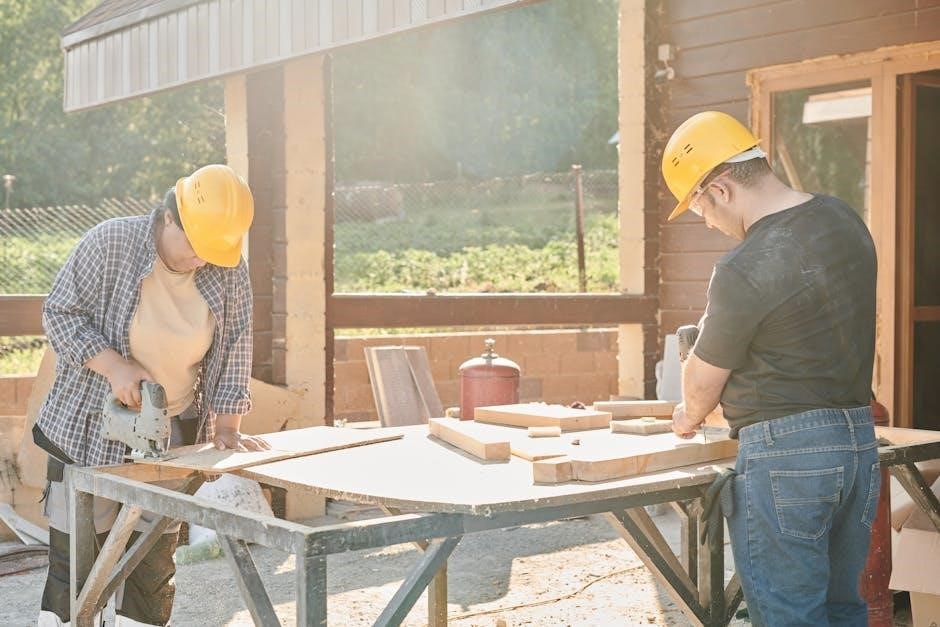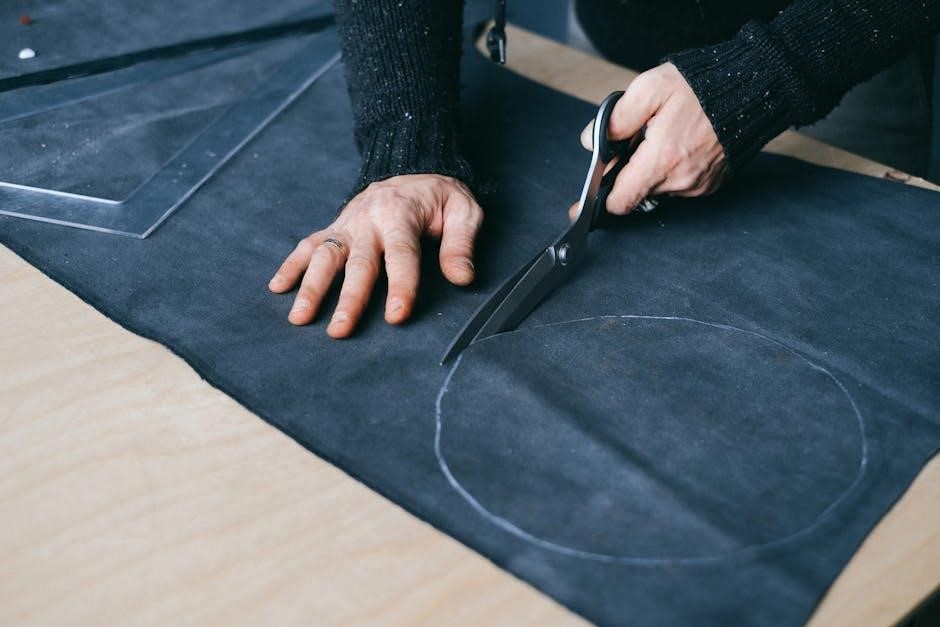Craftsman Table Saw Owners Manual: A Comprehensive Guide
Welcome to your comprehensive guide for the Craftsman table saw! This manual contains essential information for safe operation‚ maintenance‚ and troubleshooting. It covers various models‚ ensuring you have the knowledge to maximize your saw’s potential and longevity.
Craftsman table saws have a long and storied history in the world of woodworking‚ renowned for their reliability and versatility. These saws have been a staple in workshops and job sites for decades‚ offering a blend of performance and affordability that appeals to both hobbyists and professionals. Understanding the nuances of these machines is crucial for achieving accurate and safe cuts. Whether you’re ripping boards‚ crosscutting stock‚ or creating intricate joinery‚ a Craftsman table saw can be an indispensable tool.
This manual provides a comprehensive overview of Craftsman table saws‚ encompassing safety guidelines‚ operational procedures‚ maintenance tips‚ and troubleshooting advice. We aim to empower you with the knowledge necessary to operate your saw safely and efficiently. From understanding the various components to mastering essential techniques‚ this guide will serve as your go-to resource for all things Craftsman table saw related. We delve into specific models and common issues‚ ensuring you’re well-prepared to tackle any woodworking project with confidence.
Understanding Your Craftsman Table Saw Model
Identifying your specific Craftsman table saw model is paramount for accessing the correct information and replacement parts. Craftsman has produced a wide array of table saws over the years‚ each with its own unique features and specifications. The model number is typically located on a plate or sticker affixed to the saw’s frame or motor housing. Once you have identified the model number‚ you can use it to find the corresponding owner’s manual and parts diagrams online.
These resources will provide detailed information about your saw’s components‚ operation‚ and maintenance requirements. Understanding the specific features of your model‚ such as the blade size‚ motor horsepower‚ and fence system‚ will help you to optimize its performance and ensure safe operation. Furthermore‚ knowing your model number will be invaluable when ordering replacement parts or seeking technical support. Always refer to your model-specific manual for accurate guidance and avoid relying on generic information that may not apply to your particular saw.
Safety Instructions and Precautions
Operating a Craftsman table saw demands strict adherence to safety guidelines to prevent serious injury. Always wear appropriate personal protective equipment (PPE)‚ including safety glasses‚ hearing protection‚ and a dust mask. Before each use‚ inspect the saw for any damage or missing parts. Ensure the blade is sharp and properly installed‚ and that all guards and safety devices are in place and functioning correctly. Never operate the saw if any safety features are disabled or removed.
Keep your hands out of the blade’s path and use push sticks or push blocks to guide the workpiece when making narrow cuts. Avoid reaching over or behind the blade while it is spinning. Be mindful of kickback‚ a dangerous phenomenon where the workpiece is violently thrown back towards the operator. To prevent kickback‚ use a splitter or riving knife and avoid ripping narrow pieces of wood without proper support. Disconnect the power source before performing any maintenance or adjustments. Never operate the saw when fatigued or under the influence of drugs or alcohol. A safe working environment is crucial for preventing accidents.
Initial Setup and Assembly
Setting up your Craftsman table saw correctly is crucial for accurate cuts and safe operation. Begin by carefully unpacking all components and comparing them to the parts list in the manual. Ensure you have all necessary hardware and tools for assembly. If parts are missing‚ contact customer support before proceeding.
Follow the manual’s step-by-step instructions to assemble the saw stand‚ if applicable. Securely attach the saw to the stand‚ ensuring it is stable and level. Install the table extensions‚ if included‚ and align them flush with the main table surface. Mount the blade according to the manual’s instructions‚ paying close attention to the direction of rotation. Install the blade guard‚ splitter‚ and anti-kickback pawls. Adjust the rip fence and miter gauge to ensure they are square to the blade. Finally‚ connect the saw to a suitable power outlet‚ verifying the voltage matches the saw’s requirements. A properly assembled saw is the foundation for safe and precise woodworking.
Operating Procedures
Mastering the operating procedures of your Craftsman table saw is paramount for achieving accurate cuts and maintaining a safe working environment. Before initiating any cut‚ carefully inspect the workpiece for nails‚ screws‚ or other obstructions that could damage the blade or create hazardous projectiles. Always wear safety glasses and hearing protection.
Familiarize yourself with the saw’s controls‚ including the power switch‚ blade height adjustment‚ and blade angle adjustment. Ensure the blade guard‚ splitter‚ and anti-kickback pawls are properly installed and functioning. When ripping‚ use the rip fence to guide the workpiece‚ keeping your hands well away from the blade. For crosscuts‚ employ the miter gauge‚ ensuring it is securely positioned in the table slot. Never perform freehand cuts without a fence or miter gauge. Maintain a firm grip on the workpiece and feed it smoothly through the blade. Avoid forcing the material‚ as this can lead to kickback. After completing the cut‚ turn off the saw and wait for the blade to come to a complete stop before removing the workpiece.
Maintenance and Troubleshooting

Regular maintenance is crucial for ensuring the longevity and optimal performance of your Craftsman table saw. Before performing any maintenance‚ disconnect the saw from the power source to prevent accidental start-ups. Clean the saw table‚ blade‚ and internal components regularly using a brush or vacuum to remove sawdust and debris. Lubricate moving parts‚ such as the blade height and angle adjustment mechanisms‚ with a dry lubricant to prevent rust and ensure smooth operation.
Inspect the blade for sharpness and damage‚ replacing it as needed following the blade replacement guide. Check the alignment of the rip fence and miter gauge‚ adjusting them as necessary to maintain accurate cuts. If you encounter issues such as the saw failing to start‚ excessive vibration‚ or poor cut quality‚ consult the troubleshooting section of this manual. Common problems include a faulty power cord‚ loose belts‚ or a dull blade. By addressing these issues promptly‚ you can minimize downtime and keep your saw running smoothly.
Common Problems and Solutions
Even with regular maintenance‚ you may encounter problems with your Craftsman table saw. One common issue is the saw failing to start. This could be due to a tripped circuit breaker‚ a faulty power cord‚ or a malfunctioning switch. Check the power source and cord first‚ and if those are fine‚ inspect the switch for damage. Another frequent problem is the blade not cutting straight. This can be caused by a dull blade‚ a misaligned rip fence‚ or excessive vibration. Ensure the blade is sharp and properly installed‚ and realign the fence.
Excessive vibration can stem from loose belts or motor mounts. Tighten any loose components and inspect the belts for wear. If the motor overheats‚ check for blocked ventilation and ensure the blade is not excessively dull. A dull blade requires more power and can strain the motor. By systematically diagnosing and addressing these common problems‚ you can keep your Craftsman table saw operating efficiently.
Blade Replacement Guide
Replacing the blade on your Craftsman table saw is a crucial maintenance task. Start by unplugging the saw to ensure safety. Next‚ raise the blade to its highest position. Locate the arbor nut‚ which secures the blade‚ and use the appropriate wrench to loosen it. Remember that most table saws have a left-handed thread‚ meaning you’ll turn the nut clockwise to loosen it.
Once the nut is loose‚ carefully remove the blade washer and the old blade. Clean the arbor and blade flanges before installing the new blade. Ensure the blade’s teeth are pointing in the correct direction for cutting—typically forward‚ towards the front of the saw. Replace the blade washer and tighten the arbor nut securely‚ turning it counter-clockwise. Avoid over-tightening. Finally‚ lower the blade‚ plug in the saw‚ and test the new blade on a scrap piece of wood to verify proper installation and cutting performance. Regular blade replacement ensures clean‚ efficient cuts and extends the life of your saw.
Adjusting the Rip Fence and Miter Gauge
Properly aligning the rip fence and miter gauge is essential for accurate cuts with your Craftsman table saw. The rip fence should run parallel to the blade. To adjust‚ loosen the fence lock and use a precision ruler or measuring tape to ensure the distance from the fence to the blade is consistent along its entire length. Once aligned‚ securely tighten the fence lock.
For the miter gauge‚ check its angle relative to the blade using a square. Most miter gauges have adjustable stops for common angles like 45 and 90 degrees. Loosen the adjustment screws‚ set the desired angle‚ and tighten the screws. Test the settings on scrap wood to confirm accuracy. Regularly check and adjust both the rip fence and miter gauge to maintain precision and prevent dangerous kickback. A well-adjusted saw ensures safe and accurate woodworking.
Warranty Information
Your Craftsman table saw typically comes with a limited warranty‚ protecting against defects in materials and workmanship. The warranty period can vary‚ often lasting one year from the date of purchase. To ensure coverage‚ register your saw online or by mail‚ keeping the purchase receipt as proof of ownership.

The warranty usually covers repairs or replacements of defective parts‚ excluding normal wear and tear‚ misuse‚ or unauthorized modifications. If you encounter a problem covered by the warranty‚ contact Craftsman customer support or an authorized service center. Be prepared to provide your saw’s model number‚ serial number‚ and proof of purchase. Familiarize yourself with the specific terms and conditions outlined in your warranty documentation to understand the extent of coverage and any limitations. Proper use and maintenance are essential to keep your warranty valid.
Finding Replacement Parts
Locating replacement parts for your Craftsman table saw is crucial for maintaining its performance and extending its lifespan. Start by identifying the specific model number of your saw‚ usually found on a label attached to the machine’s frame. With the model number‚ you can begin your search for compatible parts.
Several online retailers specialize in Craftsman parts‚ including Sears Parts Direct and other aftermarket suppliers. These websites often provide detailed parts diagrams and lists‚ making it easier to identify and order the correct components. When ordering‚ double-check the part number to ensure compatibility. Consider consulting the saw’s owner’s manual for a comprehensive parts list and exploded views‚ which can further aid in identification. In some cases‚ you may find suitable replacement parts at local hardware stores or tool supply outlets. When searching for parts‚ consider used marketplaces.

Downloading Manuals Online
Accessing a digital copy of your Craftsman table saw owner’s manual can be incredibly convenient‚ providing instant access to important safety guidelines‚ operating instructions‚ and maintenance procedures. Many online resources offer downloadable manuals for a wide range of Craftsman table saw models.
Sears Parts Direct is a primary source for locating and downloading Craftsman manuals. Simply visit their website and enter your saw’s model number to find the corresponding manual in PDF format. Websites dedicated to vintage machinery often host a collection of older Craftsman manuals‚ useful if you own an older model. Always download manuals from reputable sources to ensure accuracy and avoid potentially harmful files. After downloading‚ save the manual to your computer or mobile device for easy access whenever needed. Having a digital manual readily available can be invaluable for troubleshooting issues‚ understanding specific features‚ and performing routine maintenance tasks‚ ensuring your table saw operates safely and efficiently.
Customer Support and Resources
Craftsman provides various customer support channels and resources to assist table saw owners with any questions or issues they may encounter. The primary avenue for support is often through Sears Parts & Repair Center‚ which can be reached via phone or online. Their website offers access to FAQs‚ troubleshooting guides‚ and detailed parts diagrams to help diagnose and resolve common problems.

Craftsman’s official website‚ often accessible through Sears‚ offers additional resources such as product manuals‚ how-to articles‚ and safety information. For technical support‚ a customer help line is available‚ providing expert assistance with operating procedures‚ maintenance‚ and repairs. Online forums and communities dedicated to woodworking and Craftsman tools can also be valuable sources of information and peer support. These platforms allow users to share their experiences‚ ask questions‚ and receive advice from other Craftsman table saw owners. Utilizing these customer support and resources ensures you can effectively maintain and troubleshoot your table saw‚ maximizing its performance and lifespan.

No Responses